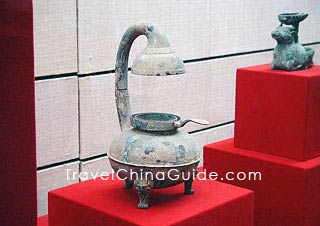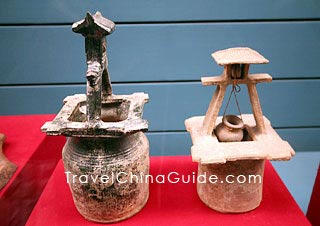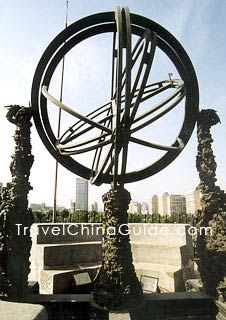Eastern Han Dynasty
 |
| Three-legged Bronze Lamp, Eastern Han Dynasty |
Regarded as a continuation of the Western Han Dynasty (206 BC - 24 AD), the Eastern Han Dynasty (25 AD - 220 AD) was established by Liu Xiu, who became the Emperor Guangwu. With Luoyang in Henan Province as its capital city, the dynasty was reined over by 12 emperors in a span of 195 years.
Political History
In the year of 25, Liu Xiu, a descendant of Western Han royalty defeated Wang Mang, who had usurped the throne of the Western Han, thus establishing the Eastern Han. In his second year on the throne, he revised all the policies that Wang Mang had set.
The most prosperous period of Eastern Han was the middle period of the first century. After the reigns of Emperors Guangwu, Ming and Zhang, the Han Dynasty regained its prosperity. Overall, its economical, scientific and cultural development surpassed that of the Western Han.
 |
| Potteries of Eastern Han Dynasty |
After the middle period of the Eastern Han, most of the emperors were juveniles and the real royal power was held by both distant relatives and eunuchs. This caused darkness and corruption in the later period when farmers all over the country launched rebellions against their rulers. In 184, the Yellow Turbans Uprising, launched by a Hebei farmer Zhang Jiao, hit the regime hard. In the late period, royal power totally fell into the hands of eunuchs which put the court into chaos. During the reign of the last emperor of Eastern Han, Emperor Xi'an, royalty was dominated by the treacherous court official Dong Zhuo. Finally, Cao Cao, a minor warlord, seized power and Emperor Xi'an was forced by Cao Pi (the second son of Cao Cao) to abdicate. Thus, the Eastern Han Dynasty came to an end.
Economy
In the early period, the central government focused much attention on irrigation works. In the reign of Emperor Ming, many fields that had been flooded by the Yellow River were changed into fertile lands.
 |
| Armillary Sphere invented by Zhang Heng, Eastern Han Dynasty |
At the same time, the productivity of industry was greatly improved. A special tool called 'Shui Pai' was invented by a local viceroy in Nanyang. This device permitted the power of water to be applied to the air-blasting in the process of iron smelting which promoted productivity in the metallurgical industry.
In the time of Emperor He, the extraction of copper, bronze-ware manufacturing and silk-making industry were developed. Commerce also prospered and the capital city Luoyang became the national business center.
Science and Culture
Some crucial changes in science and culture also took place in this dynasty. In 105, a court official named Cai Lun improved the previous method of making paper, which ended the use of inscribed bamboo strips.
Meanwhile, great progress was made in astronomy. The famous astronomer, Zhang Heng, created special equipment, which was considered as the earliest seismograph in the world, with superb techniques for testing earthquakes.
In addition, fruitful achievements in medicine were made by the well-known surgeon of ancient China, Hua Tuo, who originated the use of anesthetic techniques in operations.
In Eastern Han, the arts began to gain status. Calligraphy and painting were no longer purely used as letter symbols. Instead, their charm as arts started to emerge. What's more, with the development of ceramics, pottery came into wide-spread use among common people.
As far as I know, the east part of the country stretched to North Korea and the west border was on the east part of Kazakhstan. The south border was in the north part of Vietnam and the north border in the south part of Mongolia.
Han Dynasty is one of the most prosperous dynasty in ancient China. For a civilisation to experience its golden age, there must be support from leaders. Good leaders contributed to the development of the arts and sciences by giving their support e.g. Gupta Dynasty and Majapahit kingdom. Also, a civilisation with golden age must have been an open society to allow intellectual and cultural development to take place. An open society is one which enabled ideas from abroad to enter and allowed cultural and intellectual exchanges to take place. E.g. Contact w othr civilisations during the Tang Dynasty allowed new ideas to ender China and provided the Chinese with knowledge of the outside world, and cultural influences from abroad were seen, e.g. Tang Dynasty---the taste for imported goods among the wealthy and for foreign fashions in clothing. Therefore, please comment if you know of any articles/ websites/ evidence that can show that the Han Dynasty was one which received support from leaders and was an open society! Thanks! I would really appreciate it! ^-^